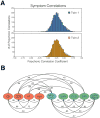Implications of the Hierarchical Structure of Psychopathology for Psychiatric Neuroimaging
- PMID: 28713866
- PMCID: PMC5505667
- DOI: 10.1016/j.bpsc.2017.02.003
Implications of the Hierarchical Structure of Psychopathology for Psychiatric Neuroimaging
Abstract
Research into the neurobiological substrates of psychopathology has been impeded by heterogeneity within diagnostic categories, comorbidity among mental disorders, and the presence of symptoms that transcend diagnostic categories. Solutions to these issues increasingly focus neurobiological research on isolated or narrow groupings of symptoms or functional constructs rather than categorical diagnoses. Here we argue for a more integrative approach that also incorporates the broad hierarchical structure of psychopathological symptoms and their etiological mechanisms. This approach places clinical neuroscience research in the context of a hierarchy of empirically defined factors of symptoms such as internalizing disorders, externalizing disorders, and the general factor of psychopathology. Application of this hierarchical approach has the potential to reveal neural substrates that nonspecifically contribute to multiple forms of psychopathology and their comorbidity, and in doing so, facilitate the study of mechanisms that are specific to single dimensions and subsets of symptoms. Neurobiological research on the hierarchy of dimensions of psychopathology is only just beginning to emerge, but has the potential to radically alter our understanding of the neurobiology of abnormal behavior.
Keywords: Comorbidity; Externalizing; Internalizing; Research Domain Criteria; Transdiagnostic; fMRI.
Figures


Comment in
-
On the Hierarchical Organization of Psychopathology and Optimizing Symptom Assessments for Biological Psychiatry.Biol Psychiatry Cogn Neurosci Neuroimaging. 2017 May;2(4):300-302. doi: 10.1016/j.bpsc.2017.03.012. Epub 2017 Apr 28. Biol Psychiatry Cogn Neurosci Neuroimaging. 2017. PMID: 29560916 Free PMC article. No abstract available.
-
"If the Shoe Fits …": The Hierarchical Structure of Psychopathology and Psychiatric Neuroimaging.Biol Psychiatry Cogn Neurosci Neuroimaging. 2017 May;2(4):303-304. doi: 10.1016/j.bpsc.2017.03.015. Epub 2017 Apr 28. Biol Psychiatry Cogn Neurosci Neuroimaging. 2017. PMID: 29560917 Free PMC article. No abstract available.
References
-
- Insel T, Cuthbert B, Garvey M, Heinssen R, Pine DS, Quinn K, et al. Research domain criteria (RDoC): Toward a new classification framework for research on mental disorders. Am J Psychiatry. 2010;167:748–751. - PubMed
-
- Sanislow CA, Pine DS, Quinn KJ, Kozak MJ, Garvey MA, Heinssen RK, et al. Developing constructs for psychopathology research: research domain criteria. J Abnorm Psychol. 2010;119:631–639. - PubMed
Grants and funding
LinkOut - more resources
Full Text Sources
Other Literature Sources
